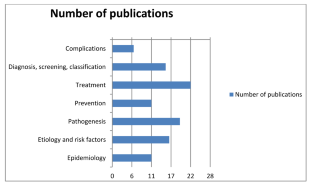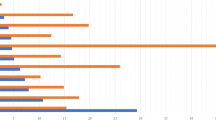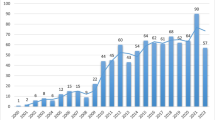Abstract
Aim
This bibliometric analysis aims to evaluate the characteristics and impact of the top 100 cited articles published under the title of diabetes mellitus.
Metods
We performed to define the most cited articles in diabetes research by using the Web of Science. The papers were analyzed in terms of their year of publication, journal of publication, authors, impact factor (IF), total citations number, the average number of citations per year, studies topic, and type.
Results
The number of citations ranged from 1519 to 17.298. They were published from 1987 to 2018. The most cited articles were published in the New England Journal of Medicine (n = 26), followed by Diabetes Care (n = 17) and Lancet (n = 9). The original scientific paper was the most popular article type (46%), followed by review article (36%). The generality studies’ subject was about treatment (n = 22), followed by pathogenesis (n = 19), etiology and risk factors (n = 16), diagnosis, screening, classification (n = 15), epidemiology (n = 11), prevention (n = 11) and complications (n = 6). There was a correlation between the average number of citations per year (ACpY) and IF (p = < 0.010, r = 0.259), citations and ACpY (p = < 0.001, r = 0.646), citations and time (p = 0.008, r = 0.266).
Conclusion
This study showed that original scientific papers were the most-cited and more articles were published in influential journals. Articles on diabetes treatment and pathogenesis were popular topics. Future interventions should focus on the management and prevention of diabetes.

Similar content being viewed by others
References
International Diabetes Federation. (2021) IDF Diabetes atlas. 10th edn. http://www.idf.org/diabetesatlas.
Bellary S, Kyrou I, Brown JE, Bailey CJ. Type 2 diabetes mellitus in older adults: clinical considerations and management. Nat Rev Endocrinol. 2021;17(9):534–48. https://doi.org/10.1038/s41574-021-00512-2.
Okaiyeto K, Oguntibeju OO. Trends in diabetes research outputs in South Africa over 30 years from 2010 to 2019: a bibliometric analysis. Saudi J Biol Sci. 2021;28(5):2914–24. https://doi.org/10.1016/j.sjbs.2021.02.025.
Cole JB, Florez JC. Genetics of diabetes mellitus and diabetes complications. Nat Rev Nephrol. 2020;16(7):377–90. https://doi.org/10.1038/s41581-020-0278-5.
Shuaib W, Costa JL. Anatomy of success: 100 most cited articles in diabetes research. Therapeutic Adv Endocrinol Metabolism. 2015;6(4):163–73. https://doi.org/10.1177/2042018815580254.
Yang Y, Ma Y, Chen L, Liu Y, Zhang Y. The 100 Top-Cited Systematic Reviews/Meta-Analyses on Diabetic Research. J Diabetes Res. 2020;2020:5767582. Published 2020 Sep 11. doi:https://doi.org/10.1155/2020/5767582
Bektan Kanat B, Yavuzer H. Top 100 articles on vitamin D: bibliometric versus altmetric analysis. Bratisl Lek Listy. 2022;123(3):160–71. https://doi.org/10.4149/BLL_2022_027.
Diagnostic criteria and classification. Of hyperglycaemia first detected in pregnancy: a World Health Organization Guideline. Diabetes Res Clin Pract. 2014;103(3):341–63. https://doi.org/10.1016/j.diabres.2013.10.012.
Stout NL, Alfano CM, Belter CW, Nitkin R, Cernich A, Lohmann SK, et al. A bibliometric analysis of the landscape of cancer rehabilitation research (1992–2016. J Natl Cancer Inst. 2018;110(8):815–24. https://doi.org/10.1093/jnci/djy108.
Chen X, Chen J, Cheng G, Gong T. Topics and trends in artificial intelligence assisted human brain research. PLoS One. 2020;15(4):e231192.
Coverage analysis of Scopus: a journal metric approach. de Moya-Anegón, Chinchilla-Rodríguez F, Vargas-Quesada Z. B, Corera-Álvarez E, Muñoz-Fernández F, González-Molina A. Scientometrics 2007;73 (1):53–78.
Garfield E. 100 citation classics from the Journal of the American Medical Association. JAMA. 1987;257(1):52–9.
Diabetes Control and Complications Trial Research Group, Nathan DM, Genuth S, et al. The effect of intensive treatment of diabetes on the development and progression of long-term complications in insulin-dependent diabetes mellitus. N Engl J Med. 1993;329(14):977–86. https://doi.org/10.1056/NEJM199309303291401.
Shuaib W, Costa JL. Anatomy of success: 100 most cited articles in diabetes research. Ther Adv Endocrinol Metab. 2015;6(4):163–73. https://doi.org/10.1177/2042018815580254.
Rosas S, Schouten J, Cope M, Kagan J. Modeling the dissemination and uptake of clinical trials results. Res Eval. 2013;22:179–86.
Aksnes DW, Langfeldt L. Wouters. Citations, citation indicators, and research quality: an overview of basic concepts and theories. SAGE Open. 2019;9. https://doi.org/10.1177/2158244019829575.
Song Y, Ma P, Gao Y, Xiao P, Xu L, Liu H. A Bibliometrics Analysis of Metformin Development from 1980 to 2019. Front Pharmacol. 2021;12:645810. https://doi.org/10.3389/fphar.2021.645810. Published 2021 Apr 28.
Rena G, Hardie DG, Pearson ER. The Mechanisms of Action of Metformin. Diabetologia. 2017;60(9):1577–85. https://doi.org/10.1007/s00125-017-4342-z.
Forslund K, Hildebrand F, Hildebrand F, Nielsen T, Falony G, Le Chatelier E, et al. Disentangling type 2 diabetes and Metformin Treatment Signatures in the human gut microbiota. Nature. 2015;528(7581):262–6. https://doi.org/10.1038/nature15766.
Moghetti P, Castello R, Negri C, Tosi F, Perrone F, Caputo M, et al. Metformin Effects on clinical features, endocrine and metabolic profiles, and insulin sensitivity in polycystic ovary syndrome: a Randomized, Double-Blind, placebo-controlled 6-Month Trial, followed by Open, Long-Term Clinical Evaluation1. J Clin Endocrinol Metab. 2000;85(1):139–46. https://doi.org/10.1210/jcem.85.1.6293.
Palmer SC, Tendal B, Mustafa RA et al. Sodium-glucose cotransporter protein-2 (SGLT-2) inhibitors and glucagon-like peptide-1 (GLP-1) receptor agonists for type 2 diabetes: systematic review and network meta-analysis of randomised controlled trials [published correction appears in BMJ. 2022 Jan 18;376:o109]. BMJ. 2021;372:m4573. Published 2021 Jan 13. doi:https://doi.org/10.1136/bmj.m4573
Liu H, Guo L, Xing J, et al. The protective role of DPP4 inhibitors in atherosclerosis. Eur J Pharmacol. 2020;875:173037. https://doi.org/10.1016/j.ejphar.2020.173037.
Deacon CF. Dipeptidyl peptidase 4 inhibitors in the treatment of type 2 diabetes mellitus. Nat Rev Endocrinol. 2020;16(11):642–53. https://doi.org/10.1038/s41574-020-0399-8.
Naderpoor N, Shorakae S, Joham A, Boyle J, De Courten B, Teede HJ. Obesity and polycystic ovary syndrome. Minerva Endocrinol. 2015;40(1):37–51.
Brown AE, Walker M. Genetics of insulin resistance and the metabolic syndrome. Curr Cardiol Rep. 2016;18(8):75. https://doi.org/10.1007/s11886-016-0755-4.
Kautzky-Willer A, Harreiter J, Pacini G. Sex and gender differences in risk, pathophysiology and complications of type 2 diabetes Mellitus. Endocr Rev. 2016 Jun;37(3):278–316. https://doi.org/10.1210/er.2015-1137. Epub 2016 May 9. PMID: 27159875; PMCID: PMC4890267.
Alberti KG, Eckel RH, Grundy SM, et al. Harmonizing the metabolic syndrome: a joint interim statement of the International Diabetes Federation Task Force on Epidemiology and Prevention; National Heart, Lung, and Blood Institute; American Heart Association; World Heart Federation; International Atherosclerosis Society; and International Association for the study of obesity. Circulation. 2009;120(16):1640–5.
Zou L, Sun L. Global diabetic kidney disease research from 2000 to 2017. Medicine. 2019;98(6):e14394. https://doi.org/10.1097/MD.0000000000014394.
Jaiswal M, Schinske A, Pop-Busui R. Lipids and lipid management in diabetes. Best Pract Res Clin Endocrinol Metab. 2014;28(3):325–38. https://doi.org/10.1016/j.beem.2013.12.001.
Iftikhar PM, Ali F, Faisaluddin M, Khayyat A, De Gouvia De Sa M, Rao T. A bibliometric analysis of the top 30 most-cited Articles in Gestational Diabetes Mellitus Literature (1946–2019). Cureus. 2019;11(2):e4131. https://doi.org/10.7759/cureus.413. Published 2019 Feb 25.
Funding
The authors declare this study to have received no financial support.
Author information
Authors and Affiliations
Contributions
G UA: concept and design, interpretation of data, analyzed, wrote, reviewed, edited and approved the manuscript.
Corresponding author
Ethics declarations
Conflict of Interest
The authors report no conflict of interest and no competing interests.
Ethical statement
All authors declare that the research has been conducted according to the principles of the World Medical Association Declaration of Helsinki “Ethical Principles for Medical Research Involving Human Subjects.” This study does not require approval from an ethics committee, because it performs a bibliometric analysis/citation analysis of the existing published classical studies.
Informed consent
Informed consent is not required as our work is a retrospective international data study.
Additional information
Publisher’s Note
Springer Nature remains neutral with regard to jurisdictional claims in published maps and institutional affiliations.
Electronic supplementary material
Below is the link to the electronic supplementary material.
Rights and permissions
Springer Nature or its licensor (e.g. a society or other partner) holds exclusive rights to this article under a publishing agreement with the author(s) or other rightsholder(s); author self-archiving of the accepted manuscript version of this article is solely governed by the terms of such publishing agreement and applicable law.
About this article
Cite this article
Ulugerger Avci, G. A bibliometric perspective to the most cited diabetes articles. J Diabetes Metab Disord 22, 763–773 (2023). https://doi.org/10.1007/s40200-023-01199-0
Received:
Accepted:
Published:
Issue Date:
DOI: https://doi.org/10.1007/s40200-023-01199-0




